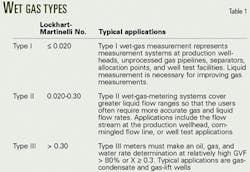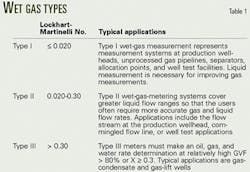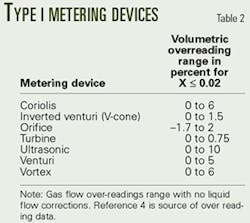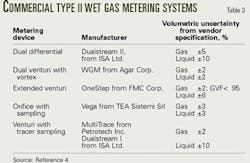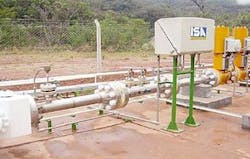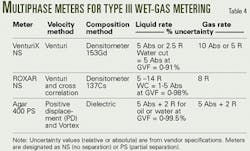New meter designs provide real-time, wet-gas flow rates that are critical in applications such as measuring production from remote and subsea fields where economics demand optimization of production, capital investment, and operating costs.
Gas production from deep water in the Gulf of Mexico has increased dramatically in the last 5 years.1 For example, in many deepwater reservoirs, economics dictate that operators combine production from several fields and process produced fluids at a central facility. In these cases, it is necessary to measure produced gas at the wellhead and to allocate production correctly to every owner in each reservoir.2
Wet-gas metering covers a wide range of liquid loading. The definition of wet gas depends on the technical or business objective such as reservoir engineering, facilities management, allocation, or commercial sales of the products.3
This article suggests a common wet-gas definition that links the various perspectives and promotes continued commercial and scientific progress in this complex technology.
Wet gas
One can simply define wet gas as gas that contains liquids, although various perspectives define and formalize the definition of wet gas differently.4
From a PVT (pressure-volume-temperature) composition perspective, reservoir engineers define gas as wet when the producing gas-liquid ratio exceeds 15,000 scf/stb for stock-tank liquid gravity up to 70° API.4
Reference 5 provides an alternative general definition of wet gas from a pipeline volumetric perspective. One determines wet-gas metering instrumentation requirements not only by the fluid definition and composition, but also by regulatory agency mandates.
Liquid mass and volume can vary from small amounts to substantial amounts of water and hydrocarbon. The liquid amount and properties as well as flow rate, temperature, and pressure of the flow stream will alter the physical response of the measurement system.
For example, a metering system and techniques for measuring gas expected to contain small amounts of water vapor (humid gas) are much simpler than the system at the wellhead for measuring gas condensate that contains substantial liquids.
Reference 4 describes the classification of different types of wet gas and organizes wet-gas metering systems into three types based only on physical properties and flow rates.
This classification is based on the Lockhart-Martinelli parameter which defines superficial velocity for liquid or gas as volumetric rate divided by the pipe cross-sectional area for gas (Vsg) and liquid (Vsl). The Lockhart-Martinelli parameter (X) is defined as:
X = (Vsl/Vsg)ρl/ρg)1/2
In the equation, rl and rg are the density of liquid and gas. The commonly used gas volume fraction (GVF) of the stream is related to Lockhart-Martinelli as:
GVF = 1/[1 + X(ρg/ρl)1/2]
From Equation 1, one can also calculate liquid-gas ratio (LGR), which is another useful term.
LGR = X(ρg/ρl)1/2
The ability to measure wet gas falls into three regions, defined by the Lockhart-Martinelli parameter. Equations 1, 2, and 3 are used to calculate the associated gas volume fraction and liquid loading in each region, thus allowing one to link GVF, LGR, and PVT and the perspectives of various end users.
Table 1 summarizes different types of wet-gas conditions and typical areas of application. One should note that the boundaries separating these three types of wet gas vary as a function of water and oil composition, pressure, and temperature, and therefore the density of the gas and liquid.
The selection of an inappropriate wet-gas meter can reduce accuracy.
The main technical challenges in choosing an appropriate metering system are as follows:
1.For end users, the challenge is to define expected production sufficiently to determine if production will be predominantly in one of the three wet-gas regions at operating conditions.
2.For vendors, the commercial challenge is to improve wet-gas meters to encompass greater range of liquid loading, thus lessening the requirements on the end users to know future production trends.
Type I meters
Table 2 lists devices that are used for metering Type I wet-gas conditions. These meters are typically used in fiscal metering.
Type I metering systems are single-phase commercial gas meters that require end users to input manually a liquid flow rate that allows calculation of a corrected gas-flow rate. These methods assume a constant liquid flow rate over a time period until input of a new end-user liquid flow rate.
End users commonly determine current liquid flow rate periodically in two or three-phase well tests, with tracer injection, from PVT predictions, and by allocation techniques.
The liquids in Type I metering systems, if uncorrected, will cause a systematic bias. If an end user enters an incorrect liquid rate, the gas measurement error by using the modified wet-gas equations4 might be greater than the uncorrected dry-gas flow calculation estimate.
Liquid measurement techniques used for correction must therefore consider anticipated liquid variation in the flow stream.
In Type I meters when X ≤ 0.02, the uncorrected error of wet-gas flow rate is relatively low. In these cases, more complex liquid corrections or installation of Type II or III meters may not improve measurement accuracy or be economically justifiable.
Type II meters
Type II wet-gas metering systems typically measure the flow stream at the production wellhead, at a commingled flowline, or during a well test. Table 3 lists several Type II commercial metering systems. Most of these meters listed in Table 3 measure gas and liquid flow rates with a differential pressure device plus another technique (Fig. 1).
Some systems use periodic sampling and tracer techniques for determining liquid flow rate and assume that liquid flow rates remain constant between sampling intervals. Other systems such as the extended venturi, dual differential, and dual venturi with vortex offer continuous measurement of gas and liquid flow rates.
End users have not corroborated fully the field-proven accuracy of these devices, but Table 3 lists the manufacturer's claimed volumetric uncertainty. Operating conditions and fluid properties most likely will increase significantly the volumetric uncertainty listed in the Table 3.
Type II wet-gas meters are for greater liquid flow ranges and for applications that have a strong economic incentive for determining accurate liquid content.
Type III meters
Type III meters are multiphase metering systems that measure flow streams composed of oil, water, and gas mixtures.
These meters include several commercially available full-bore multiphase meters as well as metering systems that use some form of flow-stream separation.
Assessment of multiphase meter performance for Type III wet-gas conditions is complex. One can characterize performance as the percent error of a reading or full scale or absolute error for each of the oil, water, and gas phases (Table 4).
There are considerable data on the field performance of multiphase meters for Type II and III wet gas.4 Field tests, comparing the performance of the multiphase meters with conventional test separators, have claimed an uncertainty of 5-10% for these meters. Some field tests have claimed even an uncertainty of 2%.
But one should note that these accuracies were obtained by comparing the gas flow measurements against conventional separators that generally use gas-metering devices described for Type I wet-gas metering conditions. In most of these field tests, the reference devices may have a questionable accuracy. With appropriate care, however, one can use data from multiphase meters for trending and process optimization.
Measurement applications
Improvements in wet-gas metering have come from two different directions.
From one direction, much effort has gone into developing correction factors and improved accuracy for Type I wet gas.4
These efforts have resulted in introducing new technology to upgrade the wet-gas measurement capability of such established single-phase devices as the orifice plate, inverted venturi (V-cone), venturi tubes, coriolis, and ultrasonic meters.
On the other hand, for Type III wet gas metering systems, manufactures have modified elements of multiphase metering technology that were intended for in-line measurements of oil, water, and gas streams.4
This approach has produced systems for handling very high GVF multiphase streams that can approach wet gas as characterized by the Types II and III wet-gas conditions in Table 1.
Wet-gas metering system cost varies considerably depending on the type of system, required accuracy, and applications such as surface or subsea deployment.
Loss of revenue is the overriding factor in selecting Type I meters used for allocation or fiscal metering.
Operators can justify Type II metering system on the basis of facility requirements (subsea). If the meter is an enabling technology, the performance requirements can be relaxed.
One can justify Type III metering system costs on the ability of these systems to provide reservoir monitoring, production optimization, flow assurance capabilities, and enabling exploitation of economically marginal subsea reservoirs.
This value-chain approach to wet-gas metering can be used to direct the selection of the technology for a specific application.
Besides cost, the end user faces other challenges in justifying a wet-gas meter for an application, such as:
- Defining range of expected production and fluid properties.
- Selecting and specifying a meter for the application.
- Obtaining the performance data and assessing the accuracy of the system for the anticipated application.
- Obtaining the approval to use a wet-gas meter for the intended application from appropriate regulatory bodies.
- Proving and calibrating the installation.
Currently, there is no commonly accepted method to assess wet-gas meter performance, as noted by the various formats to describe uncertainty in Tables 2-4. The user must gather performance information from various sources such as described in Reference 4.
The industry needs to develop a commonly accepted performance test protocol and a procedure to evaluate the performance or accuracy of these systems.
The API committee on petroleum measurement is attempting to develop guidelines and recommended practices for wet gas and multiphase meters.
Because of the increased interest in wet-gas metering associated with the development of reservoirs in deep water, the US Minerals Management Service (MMS)6 and API2 have initiatives underway to address the application of wet-gas meters for subsea applications.
Also the UK Department of Trade and Industry has issued guidelines that could assist users in deploying wet-gas metering systems5.
References
1. "Gulf of Mexico deep water production hits record level," OGJ, Apr. 8, 2002, p. 30.
2. Hasshol, T., et al., "Development of an API recommended engineering practice for wet gas flow meters for subsea allocation of hydrocarbon," 5th International Symposium on Fluid Flow Measurement, Arlington, Va., Apr. 7-10, 2002.
3. Jamison, A.W., "Wet Gas Metering—The Unexpected Challenge, Status and Trends on Technology and Applications," 19th International North Sea Measurement Workshop, Kristansand, Norway, Oct. 22-25, 2001.
4. Mehdizadeh, P., Marrelli, J., and Ting, Ven C., "Wet Gas Metering: Trends in Applications and Technical Developments," Paper No. SPE 77351, SPE Annual Conference and Exhibition, Sept. 29-Oct. 2, 2002, San Antonio.
5. "Guidance Notes For Petroleum Measurements Under The Petroleum (Production) Regulations," UK Department of Trade and Industry, Oil and Gas Division, Issue 6, October 2001.
6. Guidry, John, "MMS Views on Multiphase Metering," Texas A&M University Multiphase Measurement Roundtable, May 8, 2002, Houston.
The authors
Parviz Mehdizadeh is a consultant with Production Technology Inc. He previously worked for Conoco Inc. Mehdizadeh holds a BS and MS in physics and PhD in chemical engineering and materials science from University of Oklahoma. He is a member of SPE well operations committee and is currently working with the API committee on petroleum measurements
Jack Marrelli is a research associate with ChevronTexaco Corp. in Houston. Marrelli holds a BS and an MS in electrical engineering and a PhD in bio-engineering from the University of Connecticut.
V.C. (Frank) Ting is a senior staff research scientist in advanced production technology team with ChevronTexaco Corp. in Houston. Ting holds a PhD in mechanical engineering from the University of Utah.
